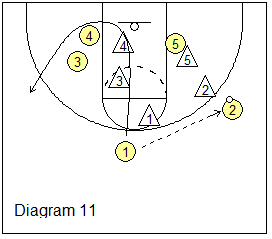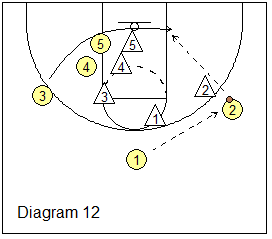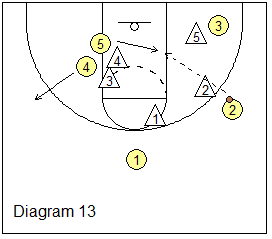Basketball Offense - Attacking the Pack Line Defense
By Dr. James Gels, From the Coach’s Clipboard Basketball Playbook"Helping coaches coach better..."
Disclosure: This page contains affiliate links, which means that Coach's Clipboard receives a small commission (at no cost to you) if you make a purchase using these links.
The pack-line defense is a sagging man-to-man defense developed by Dick Bennett for the Washington State University Cougars, and is used by his son Tony Bennett, Chris Mack, Sean Miller and others. See this article on the pack line defense to understand what the defense is trying to accomplish.
Briefly, the pack line defense pressures the ball while the other four defenders stay inside the imaginary pack line arc (diagram A) and clog the seams and paint. Off-ball defenders give early help on the dribble-drive and invite you to shoot 3-pointers, with the assumption that your shooters can't make enough 3-pointers to beat them. Pack line defenders play cutters and screens physically, and the pack line usually forces a slower-paced tempo with fewer offensive possessions.
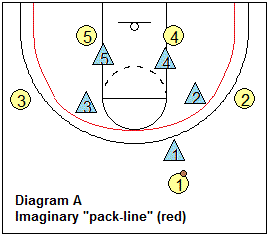
So how can we attack the pack line defense? Here are some things that we have done with some success.
Quick Offensive Transition/Fast-Break
The pack-line is a tough defense to attack and requires patience once you are in the half-court set. So attack it with up tempo transition and an early attack. A good fast-breaking team creates problems for the pack-line. So get the ball up the floor quickly before the defense can get set.Spacing
To help open the gaps for the dribble-drive, and to stretch the defense to get open 3-pointers, you must space your perimeter players out on the arc. In starting your offense, run the wings deep into the corners and use a 4-out set. Basket cutters should complete their cuts by filling all the way out to the arc and not clogging the paint and baseline. Often I have had to tell players "don't get stuck on the baseline - get out after cutting!" Similarly, players involved in screens should get good separation and spacing after the screen.Dribble-at/back-cuts help create spacing, defensive movement and confusion. Diagram 2 shows O1 dribbling at O3, and O3 cuts through while O2 rotates up to fill O1's spot. Diagram 3 shows O1 dribbling at O2, so O2 cuts through while O3 and O4 rotate over and up.
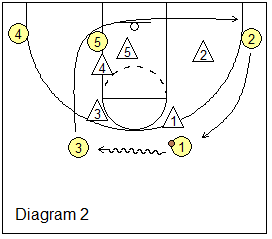
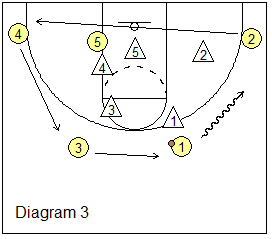
Drive and Kick
You have to be able to dribble-drive and kick out to the open teammate for a 3-pointer. But a couple caveats first: don't try to dribble-attack after the first pass to the wing. Get a ball-reversal before dribble-attacking.The dribble-penetrator has to be under control, and realize that he/she will probably not be able to get to the hoop. Instead, when the help comes, the dribbler may have to make a jump-stop, pivot, and pass to the open man. And your shooters have to make some outside shots. Attack the offensive boards for put-backs.
See the images below to see several dribble attacks, the rotations, and the possible passes for each.
Dribble attack from the top (diagrams 4 and 5):
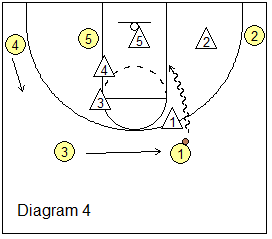
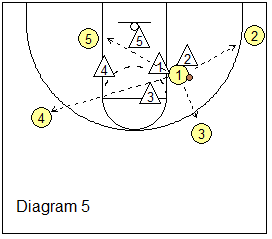
Dribble attack from the wing (diagrams 6 and 7):
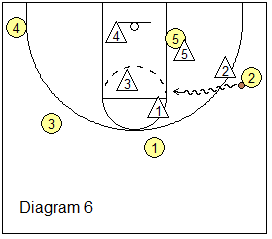
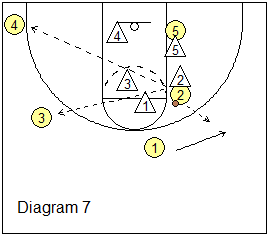
Baseline dribble attack (diagrams 8 and 9):
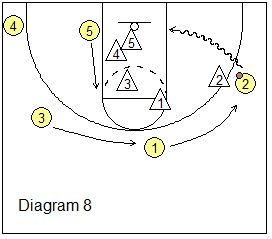
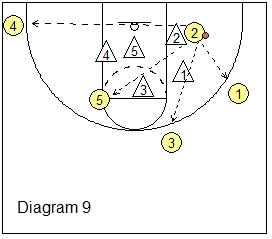
Using the principles of Jerry Petitgoue's dribble-drive zone offense may also be a good way to attack the pack line defense.
2 or 3 Good Shooters
Since the pack line defense wants you to shoot 3-pointers, put two or three of your best outside shooters on the floor and let them shoot. If they can make some 3's, the pack line will have trouble and the opponent may have to change defenses.The Importance of the Weakside
Creating offensive actions on both sides of the floor is important as this will help occupy and confuse those inside help defenders. Run weakside flare screens. I really like screening the back side of the defense and using the "pin and skip". Pin (back-screen) the help defenders in the paint, have a good shooter flare to the opposite wing-corner area, hit him with a wing to wing skip pass for the open shot (see diagram 10). If a screened defender runs out to the shooter, he might be able to make a quick pass to the screener inside sealing for position.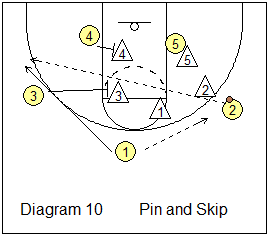
Backside screens and skip passes get the defense moving.
Also run shooters off of screens on the weak-side of the floor. Diagrams 11, 12, and 13 show a double staggered screen on the weakside.
